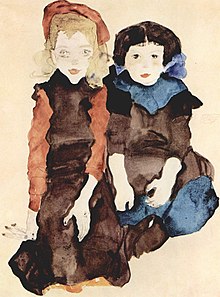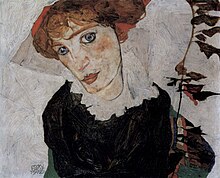Egon Schiele (June 12, 1890 – October 31, 1918) was an Austrian painter. A protégé of Gustav Klimt, Schiele was a major figurative painter of the early 20th century.
Schiele's work is noted for its intensity, and the many self-portraits the artist produced. The twisted body shapes and the expressive line that characterize Schiele's paintings and drawings mark the artist as an early exponent of expression!ism, although still strongly associated with the art nouveau movement (Jugendstil).
The Leopold Museum, Vienna houses perhaps Schiele's most important and complete collection of work, featuring over 200 exhibits. Other notable collections of Schiele's art include the Egon Schiele-Museum, Tulln and Österreichische Galerie Belvedere, Vienna.
Self-portrait, 1912
Biography
Egon Schiele was born in Tulln on the Danube. His father, Adolph Schiele, worked for the Austrian State Railways as a station master; his mother, Marie Soukup(ová), was from Krumau, in Bohemia. As a child, he attended the school run by the Stift Klosterneuburg, where his arts teacher K.L. Strauch recognized and supported Schiele's artistic talent.
When Schiele was 15 years old, his father died from syphilis, and he became a ward of his maternal uncle, Leopold Czihaczec, who became distressed by Schiele's lack of
interest in academic studies, yet recognized his passion and talent for art. In 1906 Schiele applied at the Kunstgewerbeschule (School of Arts and Crafts) in Vienna, where Gustav Klimt had once studied. Within his first year there, Schiele was sent, at the insistence of several faculty members, to the more traditional Akademie der Bildenden Künste in Vienna in 1906. There, he studied painting and drawing, but was frustrated by the school’s conservatism. Records show that Adolf Hitler was rejected by the Akademie in 1907; this has led to a misconception that Schiele and Hitler knew each other in Vienna.
In 1907, Schiele sought out Gustav Klimt. Klimt generously mentored younger artists, and he took a particular interest in the gifted young Schiele, buying his drawings, offering to exchange them for some of his own, arranging models for him and introducing him to potential patrons. He also introduced Schiele to the Wiener Werkstätte, the arts and crafts workshop connected with the Secession. In 1908 Schiele had his first exhibition, in Klosterneuburg. Schiele left the Academy in 1909, after completing his third year, and founded the Neukunstgruppe ("New Art Group") with other dissatisfied students.
Klimt invited Schiele to exhibit some of his work at the 1909 Vienna Kunstschau, where he encountered the work of Edvard Munch, Jan Toorop, and Vincent van Gogh among others. Once free of the constraints of the Academy's conventions, Schiele began to explore not only the human form, but also human sexuality. At the time, many found the explicitness of his works disturbing.
Style
Some view Schiele's work as being grotesque, erotic, pornographic, or disturbing, focusing on sex, death, and discovery. He focused on portraits of others as well as himself. In his later years, while he still worked often with nudes, they were done in a more realist fashion. He also painted tributes to Van Gogh's Sunflowers as well as landscapes and still lifes.
Controversy
Die kleine Stadt II. View of Krumau an der Moldau, 1912-1913
In 1911, Schiele met the seventeen-year-old Valerie (Wally) Neuzil, who lived with him in Vienna and served as model for some of his most striking paintings. Very little is known of her, except that she had previously modelled for Gustav Klimt and might have been one of his mistresses. Schiele and Wally wanted to escape what they perceived as the claustrophobic Viennese milieu, and went to the small town of Český Krumlov (Krumau) in southern Bohemia. Krumau was the birthplace of Schiele's mother; today it is the site of a museum dedicated to Schiele. Despite Schiele's family connections in Krumau, he and his lover were driven out of the town by the residents, who strongly disapproved of their lifestyle, including his alleged employment of the town's teenage girls as models.
Together they moved to Neulengbach, 35 km west of Vienna, seeking inspirational surroundings and an inexpensive studio in which to work. As it was in the capital, Schiele's studio became a gathering place for Neulengbach's delinquent children. Schiele's way of life aroused much animosity among the town's inhabitants, and in April 1912 he was arrested for seducing a young girl below the age of consent.
During the same year, he also had successful shows in Zürich, Prague, and Dresden.
Schiele participated in numerous group exhibitions, including those of the Neukunstgruppe in Prague in 1910 and Budapest in 1912; the Sonderbund, Cologne, in 1912; and several Secessionist shows in Munich, beginning in 1911. In 1913, the Galerie Hans Goltz, Munich, mounted Schiele's first solo show. A solo exhibition of his work took place in Paris in 1914.
In the autumn of 1918, the Spanish flu epidemic that claimed more than 20,000,000 lives in Europe reached Vienna. Edith, who was six months pregnant, succumbed to the disease on 28 October. Schiele died only three days after his wife. He was 28 years old. During the three days between their deaths, Schiele drew a few sketches of Edith; these were his last works.
Legacy
Schiele has been the subject of a biographical film, Excess & Punishment (aka Egon Schiele Exzess und Bestrafung), a 1980 film originating in Germany with a European cast that explores Schiele's artistic demons leading up to his early death. The film is directed by Herbert Vesely and stars Mathieu Carriere as Egon Schiele with Jane Birkin as his early artistic muse and Christine Kaufman as his wife and Kristina Van Eyck as her sister. As well, his life was represented in a theatrical dance production by Stephan Mazurek called "Egon Schiele", presented in May 1995, for which Rachel's, an American post-rock group, composed a score titled Music for Egon Schiele.
Schiele's life and work have also been the subject of essays, including a discussion of his works by Richard Avedon in an essay on portraiture entitled "Borrowed Dogs." Mario Vargas Llosa uses the work of Schiele as a conduit to seduce and morally exploit a main character in his 1997 novel The Notebooks of Don Rigoberto.
Æon Flux creator Peter Chung's animation style is deeply influenced by Schiele's work.
Portrait of Wally, a 1912 portrait, was purchased by Rudolf Leopold in 1954 and became part of the collection of the Leopold Museum when it was established by the Austrian government, purchasing more than 5,000 pieces that Leopold had owned. After a 1997-1998 exhibit of Schiele's work at the Museum of Modern Art in New York City, the painting was seized by order of the New York County District Attorney and has been tied up in litigation since then by heirs of its former owner who claim that the painting was Nazi plunder and should be returned to them. The dispute has been settled on July 20th and the picture was purchased by Leopold Museum for 19 Million USD.
'미술' 카테고리의 다른 글
| Grotesque(Wiki) (0) | 2012.12.25 |
|---|---|
| Paul Gauguin(1848 - 1903) (0) | 2010.11.06 |
| 그냥 한 번 가벼운 마음으로, Ursus Wehrli tidies up art (0) | 2009.11.03 |
| Albrecht Dürer, Melencolia I (0) | 2009.10.22 |
| 그림 두 장 (FAZ) (0) | 2009.10.21 |





